[Forward]Visual Guide: Setting up My Sites in SharePoint 2013
Home
Architecture
Speaking
About
Navigation
Visual Guide: Setting up My Sites in SharePoint 2013
One of the SharePoint 2013 puzzle pieces which got some major improvements are My Sites, User Profiles and news feeds. This article describes step-by-step process of setting up the my site infrastructure in the SharePoint Farm.
Prerequisite for setting up My Sites is having user profiles import or sync up and running. You can read more on user profiles sync in my previous article.
When this has been configured, we can start configuring my sites:
The first step us to go create (according to the best practices) own web application for hosting my sites. Go to the central administration, Application management, “Manage web applications”
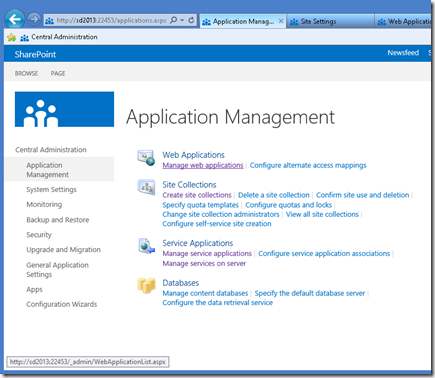
And create a dedicated web application (sd2013:101 in my example here)
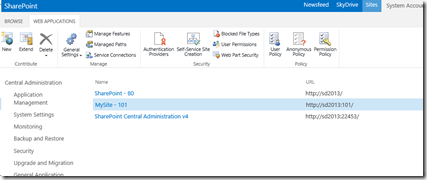
Now, the next step would be to create a site collection in the root of the newly created web application. You can of course create it inside some other managed path other than root, but since we have dedicated Web Application, root seems like an obvious choice.
Site Collection must have “2013” experience and use “My Site Host” template.
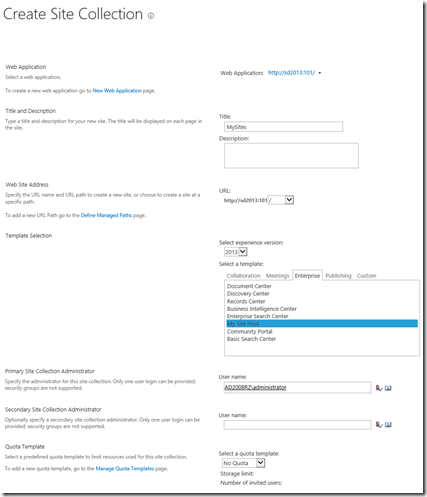
After Site Collection has been created, click on the “Managed Paths” in the web application that you created to host My Sites.
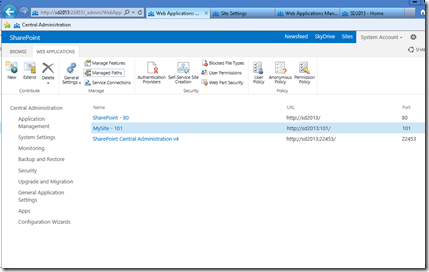
Add a new managed path with wildcard inclusion. I prefer to use “my” as the My Site managed path, but you can of course pick up anything else.
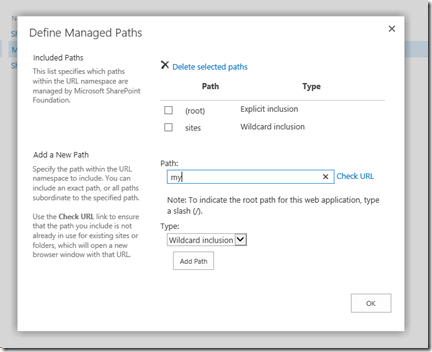
The next thing is to check service connections for the Web Application which will host my sites. Click on the “Service Connections” button to…
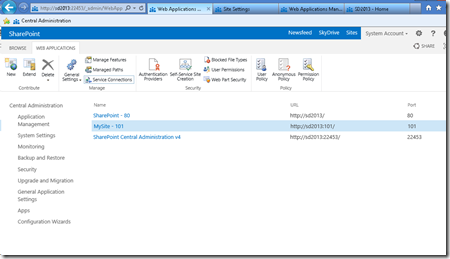
..see if right service applications are set up.
If you choose “Custom” (instead of the “Default”) in the Edit the following group of connections drop down, select any service applications to which you want to connect the web application. The most important ones re User Profile service application, the managed metadata service application, and the Search service application.
In my case, I’ll just proceed with “default”
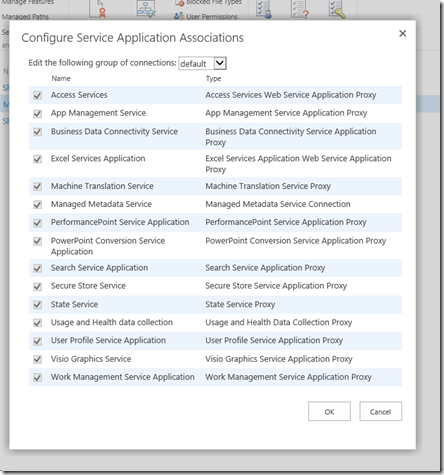
Now it’s time to set up the self service site creation. Go back to the Web application management, chose the application that you created to host My Sites, and click on the “Self Service Site Creation” button.
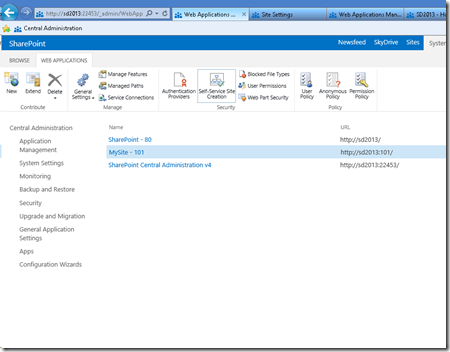
Click “On” in the “Site Collections” radio box, and enter your managed path in the “Start a Site” field (with “Prompt users to create a team site under” chosen)
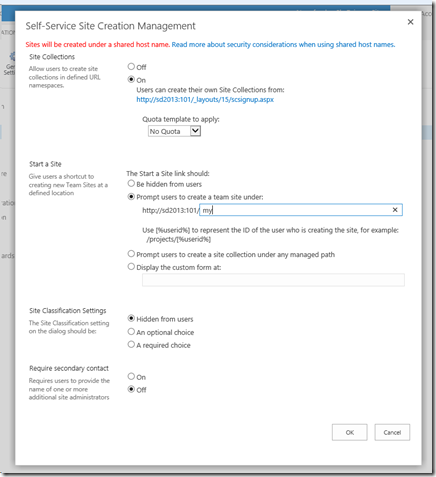
Now, the next step is to grant users permission to create new site collections (for my sites). Click on the “Permission Policy” button in the Web Application management, with the web application which hosts the my sites selected.
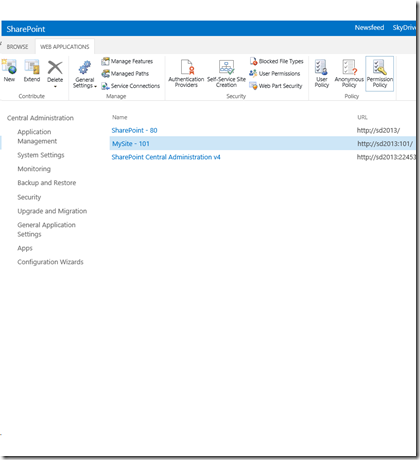
In the”Manage Permission Policy Levels”, click on the “Add Permission Policy Level”
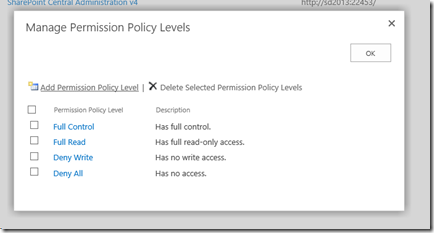
Call it however you want (“MySite Subsite Creation” in my case), and grant the “Create Subsites” permission.
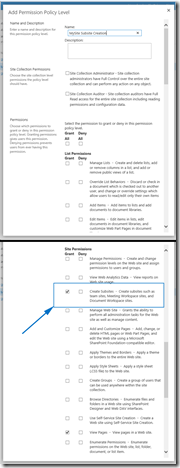
Now, the new permission policy level should appear among other policy levels…
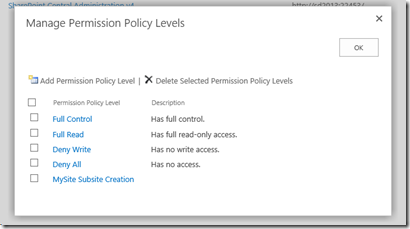
And we need to grant that policy level to the users. Click on the “Users Policy” button in the Web Application management, with the web application that you created to host My Sites selected…
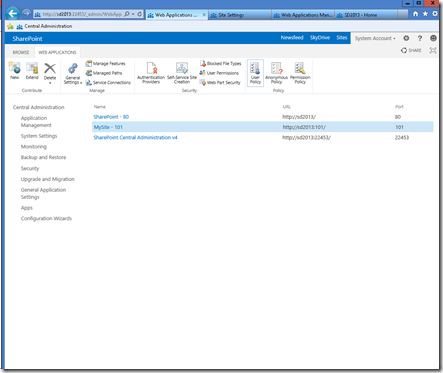
Click on the “Add users” link…
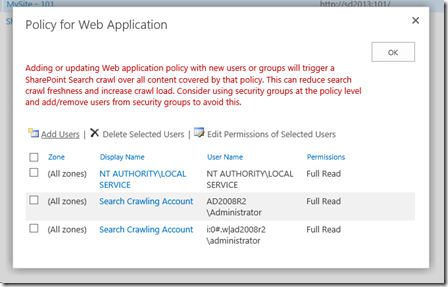
From all zones…
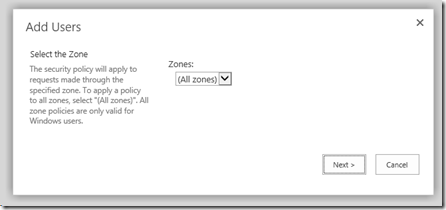
And select the users which you want to have rights to create my sites. On my case, it will be “Everyone”.
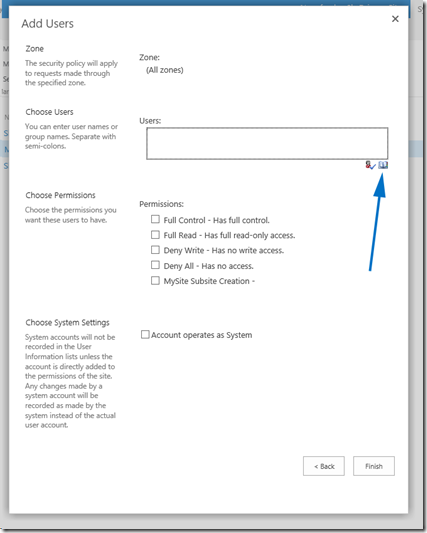
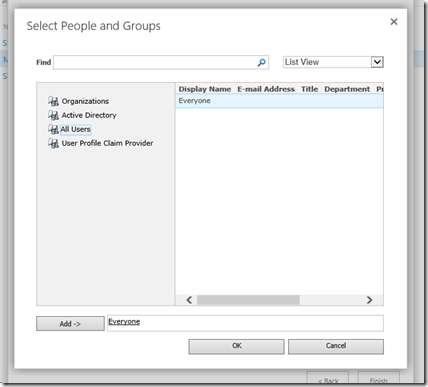
Select your newly created policy level…
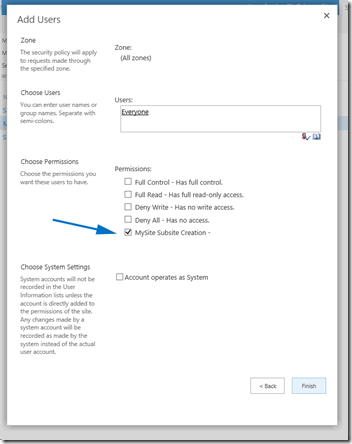
And now you should see “Everyone” with the new policy selected.
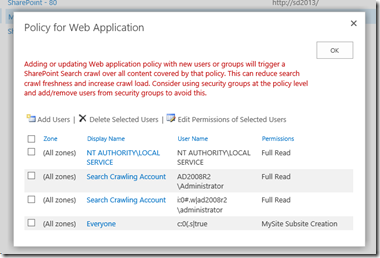
OK, everything has been set up and prepared so far. Now, finally, let’s set up the my sites. Go to the Central Administration –> Application Management, and select “Manage service applications”.
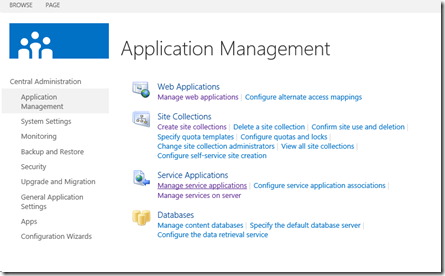
Then select the “User Profile Service Application”

In the “User Profile Service Application”, click on “Setup My Sites”
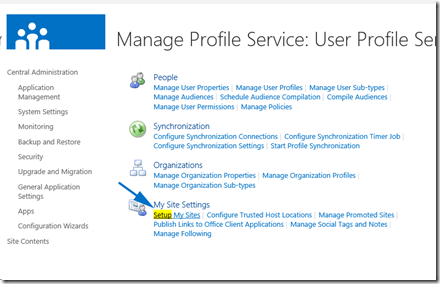
This is where you need to set up the search center, my host location (in my case – root site collection of the Web Application that serves as the host) and personal site location (managed path within the host web application – “my” in my case). Take a look at the screenshot for all the other fields (which I have used in my case):
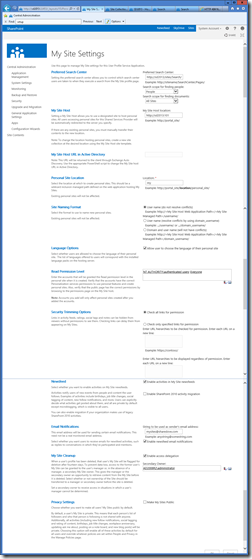
The only remaining thing would be to set up the timer job for activity feed. Go to the Central Administration –> Monitoring –>Timer Job –> Review job definitions
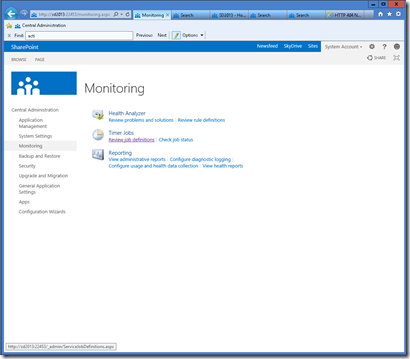
Find the “User Profile Service Application – Activity Feed Job”, and set up the activity feed sync timer according to your needs.

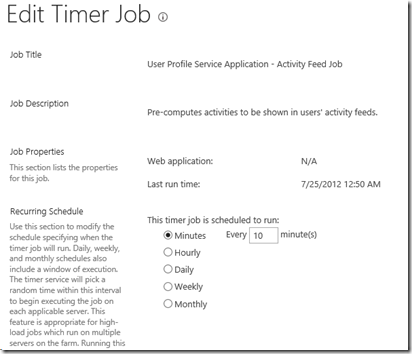
And, that’s it.
Go to the my site now, and you will be notified of my site creation for your self. Take care of your profile, follow people. Upload you private documents, share documents, follow documents – enjoy being social! ![]()
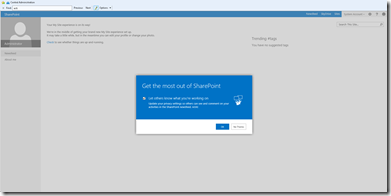
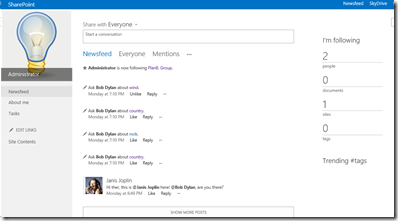
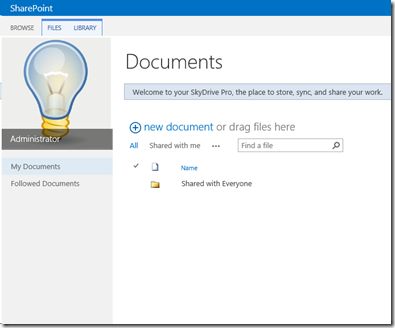
Comments
14 comments
- ← Setting up User Profile Synchronization in SharePoint 2013
- Programmatically Creating Content Databases and Site Collections →
Leave a Reply Cancel reply
You must be logged in to post a comment.
Calendar
| M | T | W | T | F | S | S |
|---|---|---|---|---|---|---|
| « Jun | Aug » | |||||
| 1 | ||||||
| 2 | 3 | 4 | 5 | 6 | 7 | 8 |
| 9 | 10 | 11 | 12 | 13 | 14 | 15 |
| 16 | 17 | 18 | 19 | 20 | 21 | 22 |
| 23 | 24 | 25 | 26 | 27 | 28 | 29 |
| 30 | 31 | |||||

Categories
Contact
MS & Community
- 1SUG BiH
- Microsoft SharePoint
- MS Community BiH
- Nothing but SharePoint
- Planet SharePoint
- SharePoint Magazine
Quick links
[Forward]Visual Guide: Setting up My Sites in SharePoint 2013的更多相关文章
- Making the Newsfeed web part available outside of My Sites in SharePoint 2013 分类: Sharepoint 2015-07-07 19:29 4人阅读 评论(0) 收藏
The Newsfeed is a key piece in SP2013's approach to social computing. It appears on the landing page ...
- Setting up your App domain for SharePoint 2013
from:http://sharepointchick.com/archive/2012/07/29/setting-up-your-app-domain-for-sharepoint-2013.as ...
- SharePoint 2013 工作流之Visual Studio开发示例篇
SharePoint 2013引用了WF4.0 Foundation,支持使用Designer和Visio进行设计,但是功能受限,而Visual Studio可以开发功能更加丰富的工作流,下面我们简单 ...
- How to copy files between sites using JavaScript REST in Office365 / SharePoint 2013
http://techmikael.blogspot.in/2013/07/how-to-copy-files-between-sites-using.html I'm currently playi ...
- MKMapView and Zoom Levels: A Visual Guide
原帖:http://troybrant.net/blog/2010/01/mkmapview-and-zoom-levels-a-visual-guide/ So, how exactly does ...
- 隐藏SharePoint 2013 team sites里的follow按钮
cls $featureid = 'a7a2793e-67cd-4dc1-9fd0-43f61581207a'$webapps = Get-spWebApplicationforeach($webap ...
- SharePoint 2013 图文开发系列之Visual Studio 创建母版页
一直以来,对于SharePoint母版页的创建,都是使用SharePoint Designer来创建和修改的,而后接触了SharePoint 2013,发现可以使用Html文件,通过设计管理器导入,然 ...
- SharePoint 2013 配置我的网站 图文引导
博客地址:http://blog.csdn.net/FoxDave 本篇我们来讲述一下关于SharePoint中我的网站(My Sites)相关的东西. 我的网站是SharePoint 2013中面向 ...
- Integrating SharePoint 2013 with ADFS and Shibboleth
Time again to attempt to implement that exciting technology, Federation Services (Web Single Sign On ...
随机推荐
- Java HexString
byte[]和十六进制字符串相互转换 Java中byte用二进制表示占用8位,而我们知道16进制的每个字符需要用4位二进制位来表示. 所以我们就可以把每个byte转换成两个相应的16进制字符,即把by ...
- android十六进制颜色代码转换为int类型数值
android开发中将十六进制颜色代码转换为int类型数值方法:Color.parseColor("#00CCFF")返回int数值;
- wikioi 2573 大顶堆与小顶堆并用
题目描写叙述 Description 我们使用黑匣子的一个简单模型.它能存放一个整数序列和一个特别的变量i.在初始时刻.黑匣子为空且i等于0. 这个黑匣子能运行一系列的命令.有两类命令: ADD(x) ...
- PHP编译错误Don't know how to define struct flock on this system, set --enable-opcache=no
编辑 /etc/ld.so.conf 加入 /usr/local/lib 再执行 ldconfig
- 10.24 noip模拟试题
尼玛pdf依旧不会粘23333 /* 每段合并到总的里面 假设总的有X个 这一段有Y个 一共有X+1个空 那么就有 C(X+1,1)+C(X+1,2)+C(X+1,3)+...+C(X+1,Y) 这样 ...
- Unity3D 5.0简单的射线检测实现跳跃功能
这里是一个简单的跳跃,5.0和其他版本貌似不一样,并且,再起跳功能做的不完全. 不过一个基本的思路在这里. 1.首先,射线检测,这里是利用一个空对象,放到主角对象的下面 2.然后调节射线的位置,在主角 ...
- CSS3 box-sizing 属性
定义和用法 box-sizing 属性允许您以特定的方式定义匹配某个区域的特定元素. 例如,假如您需要并排放置两个带边框的框,可通过将 box-sizing 设置为 "border-box& ...
- JavaMail API 1.4.7邮件发送
下载oracle javaMail API: http://www.oracle.com/technetwork/java/javasebusiness/downloads/java-archive- ...
- 【vc】14_网络编程_socket编程
1.计算机网络基本知识 最简单的网络程序如图: 提示:IP地址就相当于一个公司的总机号码,端口号就相当于分机号码.在打电话时,拨通总机后,还需要转到分机上. (1)协议 ·为进行网络中的数据交换(通信 ...
- fish code
<embed width="272" height="180" type="application/x-shockwave-flash" ...


